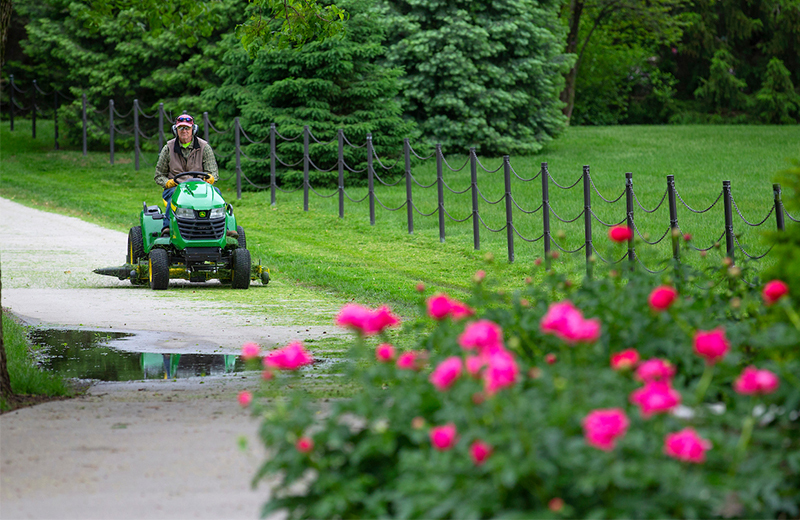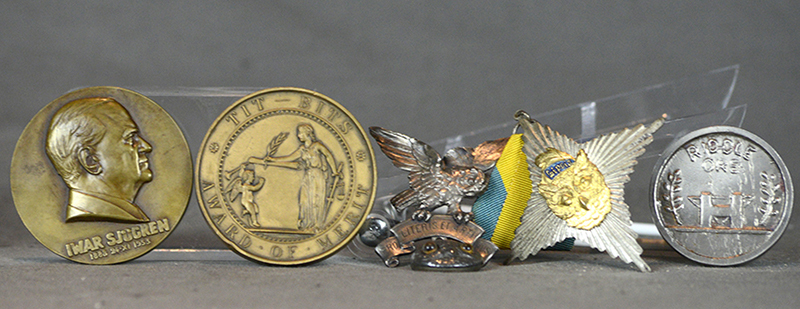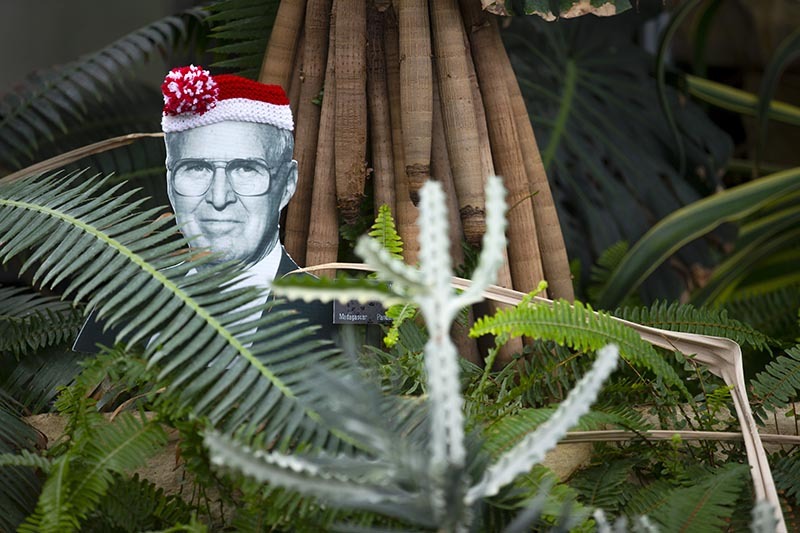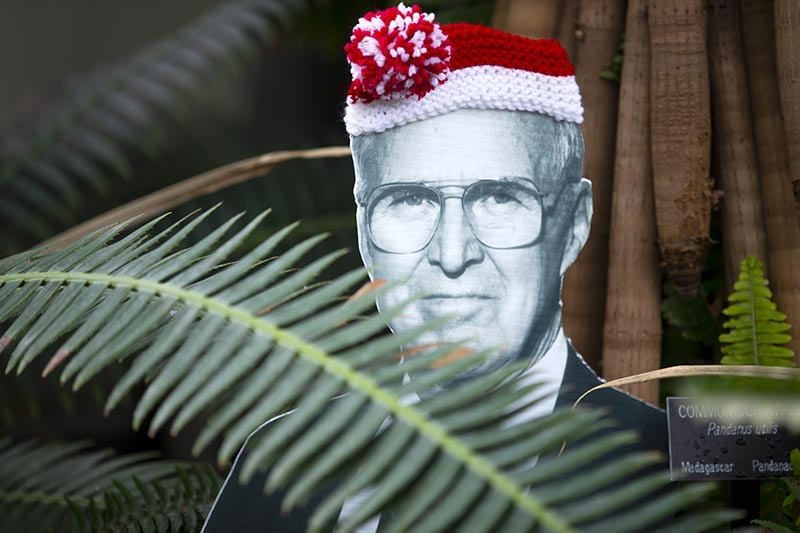Waiting on the weather

Photo by Christopher Gannon.
Doug Harjes, campus services, blows fresh grass clippings from a sidewalk west of the campanile Tuesday while dodging a puddle from another overnight rain. Harjes said some campus mowing has been delayed due to wet ground conditions.
Workday to improve student hiring process
The long lines of students bearing hiring paperwork in Beardshear Hall in August should be getting shorter. Moving to the Workday business platform this summer will streamline onboarding and managing hourly student employees.
More than 14,000 students worked as university employees during the 2017-18 school year, including nearly 11,000 undergraduates -- 1,346 of which were work-study positions. There were twice as many student workers as total faculty and staff. The annual rush of students starting new campus jobs often brings a queue outside the university human resources (UHR) service center on the third floor of Beardshear.
That's because hiring students has been a paper-based, manual process, said Tricia Stouder, an adviser in the student financial aid office who coordinates work-study employment. After students were selected for a position, they completed a paper form provided by the department and took the form and needed identification to the UHR service center. Then they returned the form to the hiring department.
"It's literally a piece of paper that gets moved by the student. When it leaves us, we don't know where it goes. We don't know where the student is at in the process," Stouder said.
After Workday goes live July 1, selecting students for campus employment won't change much. Hiring departments have different methods of filling positions, often beginning with a posting on the student job board. But the post-selection steps are all moving online to Workday. The only reason students would need to stop by the UHR service center is to show their identification for the federal I-9 form, which verifies worker eligibility.
Once the manager selects a student to hire, they'll hire the student in Workday and provide key information such as pay rate, job title, manager and workplace location. The students will be able to begin working immediately and will receive onboarding tasks in their Workday inbox. Managers will be able to monitor their students' onboarding progress.
"Has the student completed this training? Have they met with the person we asked them to meet with? We'll be able to see that as managers," Stouder said.
Units are identifying individuals to provide job management support (JM support), local roles outside of the improved service delivery service teams. The JM support roles were created to assist with hourly student employment transactions such as hiring and separating workers, transitioning students with multiple jobs to their primary job and updating compensation.
“We recognize that many areas hire a lot of student workers, and we want to ensure we have accurate and timely records,” Stouder said.
Student employees will record their working hours with Workday's time-keeping function and can receive a heads-up when they are approaching the 20-hour weekly limit.
The changes also will make it easier to analyze student employment trends to improve students' experiences, Stouder said. Under the current system, it's difficult to study or collect data on student employees. With Workday, trends will be easier to spot and additional information easier to solicit, which could help in figuring out how to create better environments for learning valuable on-the-job skills.
"It's not just about task completion," Stouder said of students working on campus. "It's really about development."
For more information on how Workday will impact student hiring, consult the computer-based Workday training session "Managing HCM Processes for Student Workers," available through Learn@ISU. For more information about student hiring in general, check out this document on student employment guidance.
State funding, tuition increases are on regents' agenda
Fall tuition, equal shares of additional state operating support, FY20 salary policy and changes to the new poultry farm plan are on the agenda when the state Board of Regents meets June 4-6 at the Alumni Center. The first day and a half is reserved for annual performance evaluations of the three regent university presidents, special schools superintendent and the board's executive director. The agenda is online, and audio of all public portions of the meeting will be livestreamed on the board's website.
New state funding
The 2019 Legislature appropriated and Gov. Kim Reynolds on May 13 approved $12 million to be shared by the three regent universities for new initiatives or to meet demands on each campus for the fiscal year that begins July 1. This appropriation is separate from the general university appropriation to each school, and the board proposal is to share it equally, $4 million to each regent university. The board sought $18 million in additional funding, $7 million of which it would have directed to Iowa State.
Salary policies
Salary policies for the new fiscal year are on the consent agenda, a list of items approved without discussion unless a board member requests removal of a specific item from the list. The board is expected to give executive director Mark Braun authority to approve salary policies when each institution submits its to him. At Inside's deadline, ISU leaders had not shared the salary parameters for faculty and professional and scientific staff. As announced this spring, the state's two-year contract with the American Federation of State, County and Municipal Employees (AFSCME), Council 61, which represents the university's approximately 1,300 merit employees, provides a 2.1% pay increase on July 1. Minimums and maximums in the merit pay matrix would be adjusted upward as well.
Final approval of tuition and fee rates
As it proposed at a special meeting May 1, the board is expected to give final approval to 2019-20 tuition increases of 3.9% for Iowa State's resident undergraduates, 4% for resident and nonresident veterinary medicine students and 4.9% for all others. The table below provides the specifics.
Proposed 2019-20 base tuition increases for ISU students
|
Students |
Tuition-only increase |
Tuition/fees price (increase) |
|
Iowa residents |
|
|
|
Undergraduate |
$302 (3.9%) |
$9,320 (3.7%) |
|
Graduate |
$456 (4.9%) |
$10,990 (4.6%) |
|
Vet Med* |
$932 (4%) |
$25,498 (3.9%) |
|
Nonresidents |
|
|
|
Undergraduate |
$1,086 (4.9%) |
$24,508 (4.8%) |
|
Graduate |
$1,156 (4.9%) |
$25,952 (4.8%) |
|
Vet Med* |
$2,050 (4%) |
$54,582 (4%) |
*Years 1-3 of the Doctor of Veterinary Medicine program
This fall, Iowa State also will begin year two of a three-year plan to align numerous differential tuitions at both the undergraduate and graduate levels into two categories: $1,600 and $2,612 ($3,026 for nonresident and international students) annually when fully implemented. Most undergraduate differential tuitions begin in the junior year, but beginning this fall Iowa State proposes assessing the differential to sophomores in engineering disciplines and the agricultural systems technology and industrial technology programs in the College of Agriculture and Life Sciences.
Farm proposals
The university is seeking final board approval for a $21.2 million, six-building feed mill and grain science complex on the Curtiss Farm south of U.S. Highway 30 at State Avenue. The facility would include a feed mill tower, education building, grain handling and storage complex, warehouse, scale and sampling building, and biosecurity/vehicle wash building. If approved, construction could begin this fall and wrap up in spring 2021.
Iowa State also is proposing a $1 million addition (to $6.8 million) to the new poultry research and teaching facility the board approved last November. It replaces a 1960s-era complex south of Ames on State Avenue. The changes to the project would add two buildings for teaching and research on turkeys, both of which also could be used for chicken research, as needed. Construction began in March and will continue through 2019 with the turkey buildings.
Both farm projects will be funded with private gifts.
Program name changes
Iowa State will seek board permission to change the name of two master's programs for consistency. The master of engineering and master of science programs in information assurance would become the master of engineering and master of science in cyber security. This reflects degree program names at other universities and also aligns with Iowa State's new bachelor's degree in cyber security.
Des Moines property sale
In non-ISU business, the University of Iowa will seek board permission to sell its Iowa Center for Higher Education campus, formerly the American Institute of Business, about 14 acres containing eight buildings on Fleur Drive in Des Moines, to The Village at Grays Lake LLC for $7.5 million.
In October 2015, the board approved AIB's gift of the property to the university, which repurposed it as the Iowa Center for Higher Education. Last year, the university decided, for programming and financial reasons, to close the center and sell the property. University leaders expect to complete the sale this summer.
Weekend sale will benefit museums

Contributed photos.
More than 750 items ranging in cost from 50 cents to over $1,000 will be on sale at a unique public sale Friday and Saturday in the Scheman Building. Proceeds from the art and antique sale go to university museums.

Betsy Grabinski, communications specialist for university museums, said many coins, medals and paintings are for sale. Jewelry, decorative arts, silver service ware, plates, textiles, furniture, books and other collectibles also will be available.
Among the most expensive items are three art glass pendant lamps, including French art nouveau works from the Daum and Gallé studios established in the late 1800s in Nancy, France. Rare coins and seldom-sold medals associated with the Schlaraffia international fraternal organization also top the list of notable objects.

Grabinski said many objects are under $50. ISU surplus also is providing sale items, including copper roof tiles from the campanile. Any unsold items will be offered at future sales. University museums will use the proceeds to conserve its permanent collection. Thousands of dollars were raised at the inaugural sale in 2015.
The sale runs from noon to 6 p.m. Friday, May 31, and 10 a.m. to 4 p.m. Saturday, June 1, in 004 Scheman. All items will be sold as marked on a first-come, first-served basis. Cash, checks and credit cards will be accepted; all sales are final. Questions can be directed to Jared Hohanshelt, interim director of logistics and support services (294-1873, jho@iastate.edu).
Find hidden heroes in conservatory exhibit

A bust of Norman Borlaug hidden in the "Where's Aldo (Leopold)?" exhibit in the Reiman Gardens conservatory. Photo by Christopher Gannon.
Ecology superstars are featured in the "Where's Aldo (Leopold)?" exhibit that opened Saturday in Reiman Gardens' Hughes Conservatory. Part of the gardens' yearlong Toys and Games theme, the exhibit is a play on the "Where's Waldo?" search-and-find puzzles.
Eight (nearly) life-sized busts are tucked among the tropical plants, flowering annuals and river birch trees on display in the conservatory. The black and white busts sport Waldo-like red and white striped scarves and hats knitted by gardens volunteers. The busts will be moved periodically, presenting a new search for returning visitors.
The eight ecology heroes featured in the exhibit are:
- Aldo Leopold, an Iowa native and conservationist known as the father of wildlife ecology
- Vandana Shiva, named a 2003 Time magazine environmental hero for promoting biodiversity in agriculture
- Norman Borlaug, an Iowa native and 1970 Nobel Peace Prize winner who founded the World Food Prize
- Rachel Carson, a marine biologist who authored a book about the threats of chemical exposure
- John Muir, the Sierra Club founder credited with launching the national park system
- Robert Bullard, an alum and environmental justice advocate for minority human populations located in polluted areas
- Marjory Stoneman Douglas, a 1993 Presidential Medal of Freedom winner for her work to preserve and protect the Florida Everglades
- Ed Pulaski, a U.S. Forest Service firefighter who saved nearly all of his crew during Idaho's "Great Fire of 1910"
Themed displays also are growing in the outside gardens. They include:
- "Herbs and Orbs" in the herb garden, featuring orb-shaped plants
- "Light Bright" in the campanile garden, featuring a grid of colorful plants with a dark backdrop
- "The Five Senses" in the children's garden, featuring plants to see, touch, smell, hear and (sometimes) taste
- "Fruit Ninjas" in the home production garden, highlighting the reproductive "fruit" of flowering plants

